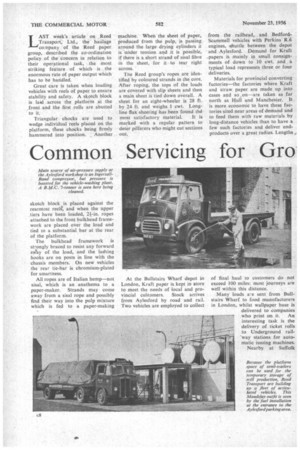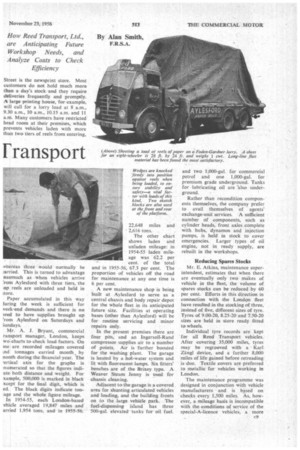Common Servicing for Gro Fransport
Page 48

Page 49

Page 50

If you've noticed an error in this article please click here to report it so we can fix it.
skotch block is placed against the rearmost reel, and when the upper tiers have been loaded, 2+-in, ropes attached to the front bulkhead framework are placed over the load and tied to a substantial bar at the rear of the platform.
The bulkhead framework is strongly braced to resist any forward svfay of the load, and the lashing hooks are on posts in line with the chassis members. On new vehicles the rear tie-bar is chromium-plated for smartness.
All ropes are of Italian hemp—not sisal, which is an anathema to a paper-maker. Strands may come away from a sisal rope and possibly find their way into the pulp mixture which is fed to a paper-making At the Bullstairs Wharf depot in London. Kraft paper is kept in store to meet the needs of local and provincial catomers. Stock arrives from Aylesford by road and rail. Two vehicles are employed to collect of final haul to customers do not exceed 100 miles: most journeys are well within this distance.
Many loads are sent from Bullstairs Wharf to food manufacturers in London, whilst wallpaper base is delivered to companies who print on it. An interesting task is the delivery of ticket rolls to Underground rail'way stations for automatic issuing machines.
Nearby at Suffolk Nbereas three would normally be :ferried. This is turned to advantage nasmuch as when vehicles arrive 'rom Aylesford with three tiers, the op reels are unloaded and held in ;tore.
Paper accumulated in this way luring the week is sufficient for veek-end demands and there is no teed to have supplies brought up 'rom Aylesford on Saturdays and >undays.
Mr. A. J. Bryant. commercial ransport manager, London, keeps wo charts to check load factors. On me are recorded mileages covered Lnd tonnages carried month. by nonth during the financial year. The rertical axis for the graphs is numerated so that the figures indiate both distance and weight. For xample, 500,000 is marked in black xcept for the final digit, which is ed. The black digits indicate tonage and the whole figure mileage.
In 1954-55, each London-based chicle averaged 19,847 miles and arried 1.954 tons, and in 1955-56. 22,648 miles and • 2,616 tons.
The other chart shows laden and unladen mileage: in 1954-55 laden mileage was 62.2 per cent, of the total and in 1955-56, 67.3 per cent. The proportion of vehicles off the road for maintenance at any one time is 6 per cent.
A new maintenance shop is being built at Aylesford to serve as a central chassis and body repair depot for the whole fleet in its anticipated future size. Facilities at operating bases (other than Aylesford) will be for routine servicing and minor repairs only.
In the present premises there are four pits, and an Ingersoll-Rand compressor supplies air to a number of points. Air is further boosted for the washing plant. The garage is heated by a holt-water system and lit with fluorescent lamps. Six fitters' benches are of the Brixey type. A Weaver Steam Jenny is used for chassis cleaning.
Adjacent to the garage is a covered area for shunting articulated vehicles and loading, and the building fronts to the large vehicle park. The
fuel-dispensing islandhas three 500-gal. elevated tanks for oil fuel.
and two 1,000-gal. for commercial petrol and one 1,000-gal, for premium grade underground. Tanks for lubricating oil are 'also underground.
Rather than recondition components themselves, the company prefer to avail themselves of agents' exchange-unit services. A sufficient number of components, such as cylinder heads, front axles complete with hubs, dynamos and injection pumps, is held in stock to cover emergencies. Larger types of oil engine, not in ready supply, are rebuilt in the workshops.
Reducing Spares Stocks
Mr. E. Atkins, maintenance superintendent, estimates that when there are eventually only two makes of vehicle in the fleet, the volume of spares stocks can be reduced by 60 per cent. Efforts in this direction in connection with the London fleet have resulted in the stocking of three, instead of five, different sizes of tyre. Tyres of 9.00-20, 8.25-20 and 7.50-20 sizes are held in store ready fitted to wheels.
Individual tyre records are kept for all Reed Transport vehicles. After covering 35,000 miles, tyres may be regrooved with a Karl Zangl device, and a further 8,000 miles of life gained before retreading is due. Textile covers are preferred to metallic for vehicles working in London.
The maintenance programme was designed in conjunction with vehicle manufacturers and is based on checks every 1,500 miles. As, however, a mileage basis is incompatible with the conditions of service of the special-A-licence vehicles, a more convenient time basis is imposed for them.
There are five different service routines nominated alphabetically and performed at 1,500, 3,000, 6,000, 30,000 and 60,000 miles. Foolscap -cards of distinguishing colours instruct workshop staff as to the respective tasks to be done at these intervals, and time spent and materials used may be entered on them so that cost of the work can be computed.
The A service, involving three hours' work, includes lubrication and general inspection. At 3,000 miles, the B service requires changes of sump and transmission oils and a check of track alignment. This routine occupies four hours. Oil filters are changed under the C service at 6,000 miles, radiators flushed and wheels changed around, entailing a docking period of six hours.
Engine Replacements At 30,000 miles, petrol engines are decarbonized and big-end bearings inspected. Similar attention is incurred by oil engines at 60,000 miles, at which period petrol engines are due for replacement. Oil engines are thoroughly inspected at 120,000 miles and are normally scheduled for replacement by new units at about 200,000 miles.
Reed Transport are responsible for the group's private-car fleet of 275, includMg medium-sized saloons of Vauxhall, Ford, Austin, Hillman, Humber and Morris manufacture,
also Rolls Royce, ArmstrongSiddeley and Jaguar products. Their maintenance and control, however,
are divorced from that of commercial vehicles.
Mr. F. J. Lewis, director in charge of the car fleet, said that one reason was that the type of mechanic who was an expert. with a heavy oiler was not necessarily au fait with an elegant limousine. At present, car maintenance is done in a garage apart from that of the lorries, but even when all such work is done under the roof of the new depot, the staffs will continue to be separated.
Importance is laid on thorough costing. Mr. E. Clegg, chief accountant, explained how the costing system had been adapted for compatibility with Powers -Samas punched-card accounting machines of modern type.
Each month all costs are collated and broken down under the following headings: A-licence lorries, trunk C-licence lorries, local C-licence and site vehicles, private cais and garage. Overheads are not further divided, but each vehicle's running costs are individually accounted.
Invoiced charges are made to group companies for transport ser
vices provided, and each vehicle has its own cost and income record. The difference between cost and income represents the contribution toward overheads, and is the figure watched by the management. lithe margin for any vehicle declines, appropriate action is taken to remedy the deficiency.
Goods petrol vehicles are dep.eciated over eight years and oilers over 10 years. The accounting machines can prepare an invoice and a cost analysis on the same card, and all vehicles' expenses under any heading—tyres, for example—can be totalled mechanically within a few minutes.
Drivers' working conditions are good and their wages are above the average for the industry. Men are awarded a weekly reliability bonus, and in addition -there is a group profit-sharing scheme applicable to all employees. There is a noncontributory pension plan. Drivers are provided with overalls and overcoats, and social and sports amenities are probably unbeaten by any other big company in Britain.
















































































































